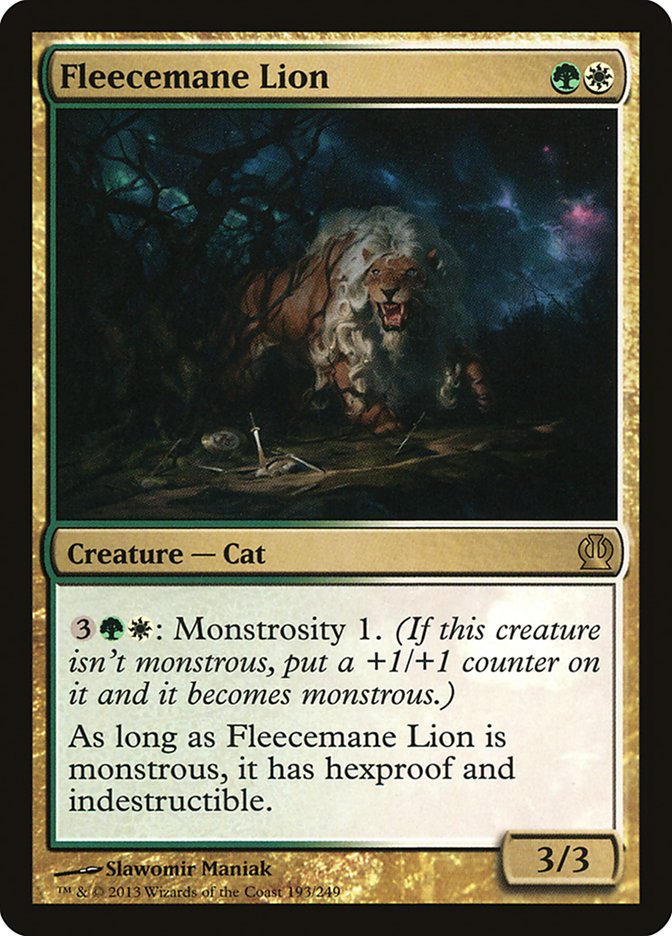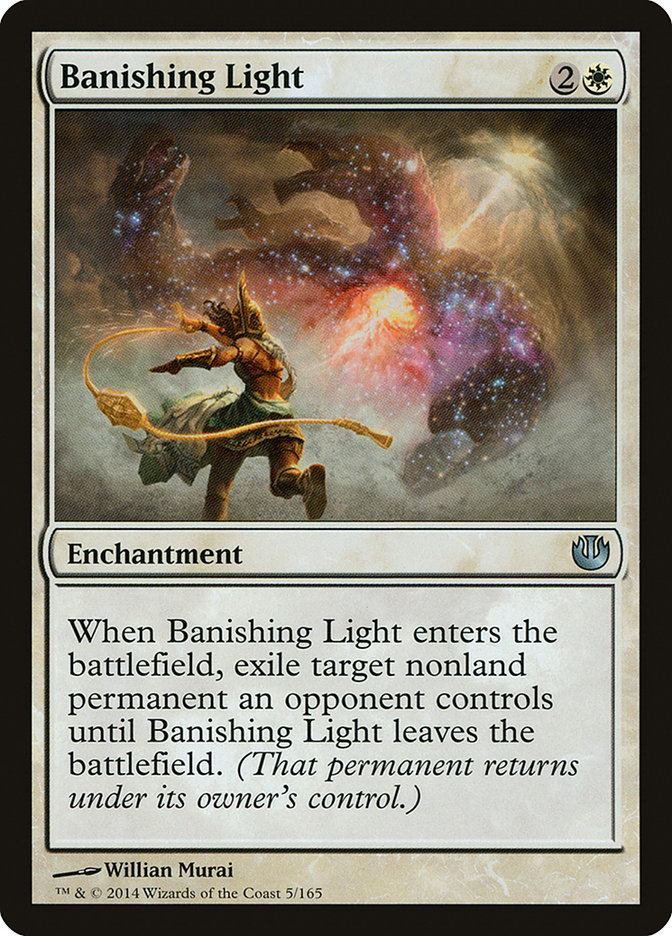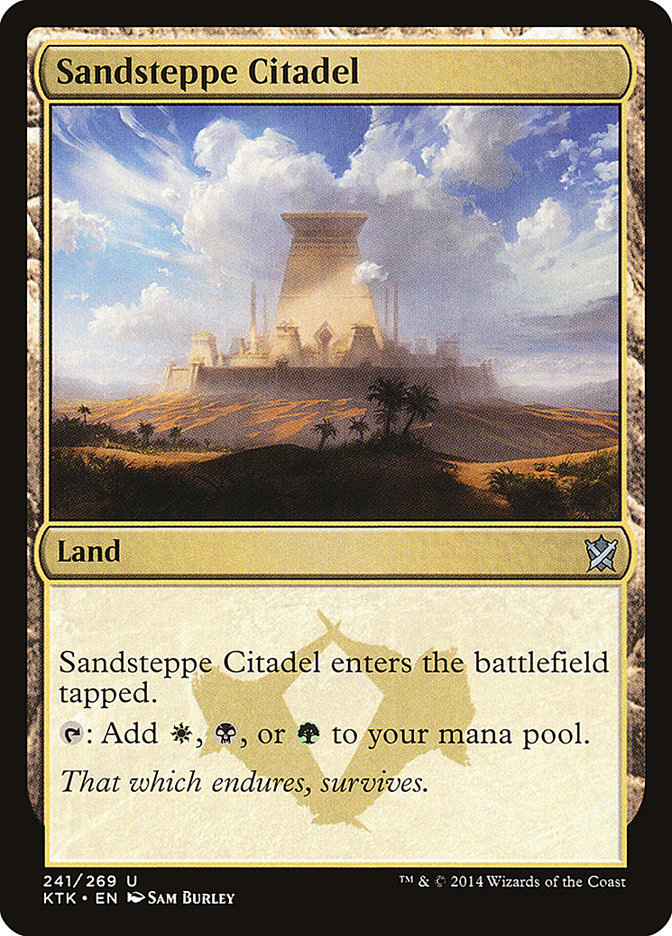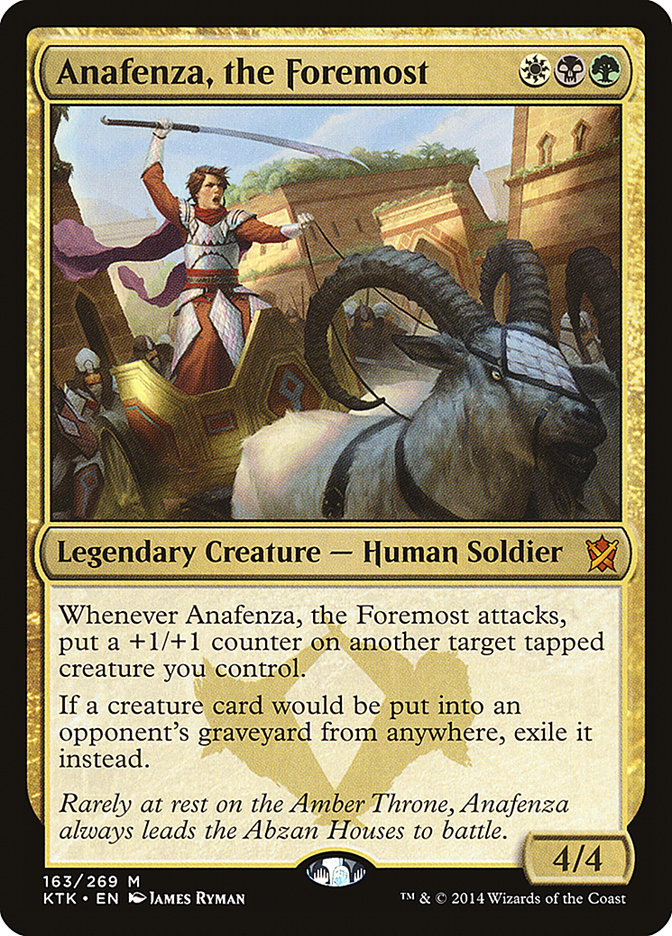This weekend, I managed to put my money where my mouth was and post a Top 4 finish in the Standard Open with the deck I’d been championing for weeks as
easily the best deck in the format: Abzan Reanimator. Even better, testing partner Gerry Thompson, having spent weeks trying to beat me before joining me,
also battled his way into the Top 4 with a very close list (we both made last-minute changes).
Following Gerry’s concession to Brad and my own on-camera woes, the deck was eliminated–but I’d like to think the finishes spoke for themselves. After
all, between the two of us we went 18-2 in matches played!
Here’s the list I played:
Creatures (23)
- 3 Hornet Queen
- 1 Elvish Mystic
- 4 Sylvan Caryatid
- 4 Courser of Kruphix
- 4 Satyr Wayfinder
- 2 Doomwake Giant
- 1 Reclamation Sage
- 4 Siege Rhino
Lands (24)
Spells (13)

Most of the differences between mine and Gerry’s list were a result of conversations with Brad before the event while I was finalizing my decklist. Both
lists are certainly a few degrees from what I’ve previously discussed, so let’s dive into the major adjustments.
Maindeck a Reclamation Sage
I implied this could be correct in my last article on the deck
, and it tested quite well. It’s mediocre in some spots but usually still relevant, and against decks featuring Whip of Erebos or Jeskai Ascendancy it’s an
incredible game 1 blowout. I was considering a second before the tournament, but wound up deciding some of my sideboard changes made this unnecessary.
Incredibly, no one once called a judge on me for casting the card in game 1. Frankly, I found it disconcerting!
No Lions, Thoughtseizes Main
This last-minute change was made just prior to the tournament beginning. Fleecemane had always been a solid but unspectacular player, and after chatting
with my testing partners I was sold that Thoughtseize would be good in our build against two of the most popular decks following Worlds, Sultai Reanimator
and Jeskai Tokens.
One of the reasons I think my deck is so great is that the Jeskai Tokens deck is also quite great, but has been a pretty good matchup for me in testing.
Adding Thoughtseize to the main certainly has helped since, and it’s also a strong card against control decks which can otherwise be tricky.
No Banishing Lights
While it’s great that Banishing Light is an enchantment for Doomwake Giant and Commune with the Gods, the truth is that the latter came up incredibly
rarely for me in testing. The Doomwake trigger was handy, but for three mana I wanted a spell that could do more.
The worst aspect of Banishing Light was that it was my planeswalker “solution” in the main, but the most problematic planeswalker to handle was frequently
Ashiok, Nightmare Weaver out of the Perilous Vault-packing U/B Control decks. I had to use Light carefully, almost always saving it to exile a creature
summoned via Ashiok’s –X before attacking Ashiok to death, helping to gain Vault insurance rather than let myself get blown out.
Once I realized the mana could support it, I made the switch to Hero’s Downfall and have never looked back. It’s a huge difference maker against U/B
Control and traditional Abzan lists, and also helped make the deck a smidge better against Sarkhan and Stormbreath Dragon as well, two cards we’d found
problematic on occasion but not worth addressing drastically. A minor adjustment that happened to splash onto these problems was very welcome, and the
difference paid dividends all weekend.
The Mana
Only two? Hear me out…
In a deck with cards like Courser and Satyr Wayfinder, every ounce of value you can extract from your manabase matters to help fight flooding and generate
initiative early. Specifically, playing more Temples and painlands in order to make your mana generate more value or tempo will manifest itself over and
over. Brad made some impassioned arguments against the playset of tri-lands, and after going to zero I finessed my way up to two. In practice, this change
was great for me, and I actually didn’t know Gerry was taking the coward’s path for most of the tournament. I believe we’re seeing eye to eye now, for what
it’s worth.
In accounting for this change, I added a second Urborg. The card is most obviously a fantastic fixer for Whip and Hero’s Downfall, but an important benefit
is the interaction with Windswept Heath. In general, you should avoid popping fetchlands in matchups where you can expect a Courser to survive in the
lategame, as the deck selection provided by a fetch already in-play is a very nice perk. This is most common against other Abzan decks, in my experience,
but it can occur elsewhere. Be on the lookout for that value!
I’m certain the mana isn’t perfect yet, but it feels very close, and I doubt I’ll play four Citadel again unless I make some very unusual card choices.
Singleton Elvish Mystic
I’d felt slightly land-light from time to time, and Brad echoed that sentiment. He’d been playing one Mystic and said it had been great for him, so I
decided to go along for the ride when I found myself with the room to make the change. While the Elf wasn’t especially bad, and was very good twice, I
think the deck naturally floods and takes advantage of its mana well enough that the mana producer is unnecessary and too low impact to take up one of my
36 most valuable slots.
I’d like to cut it and try to fit in an aggressive card lower down the curve. There are a number of options, including some from my own sideboard.
Anafenza, the Foremost Appears
Brad was very high on Anafenza, and following Worlds I’d been looking for ways to gain some percentage against Sultai Reanimator decks, as I expected them
to be more popular and somewhat difficult. In general, their deck is often a worse version of ours, because Siege Rhino is a better creature than
Sidisi–the reason I abandoned her. However, options like Ashiok, Nightmare Weaver and Disdainful Stroke can position the matchup in such a way that they
regain the driver’s seat.
I mentioned previously that one of the largest draws to this archetype is its ability to flip roles. It can play at being a legitimate midrange deck, and
it can also feel like a bit of a Hornet Queen combo deck. Anafenza is an excellent midrange contributor, and happens to be a solid hate card against Whip
mirrors.
Very significantly, Anafenza has a large body and comes down under Disdainful Stroke without dying to any of the cheap sweepers. You can easily power out
Anafenza into Rhino into a Doomwake to generate a favorable attack even against Abzan decks, which keeps most people from even trying to block you and
forces them to give you the initiative.
Landing Still in Legacy
The Standard event soaked up my day, and I’d loaned out my Tundras and some of my U/R Delver cards, which meant I didn’t have the time or interest to try
and avoid playing U/R Landstill. I wasn’t sure if my dislike for the deck was accurate or not, as it was performing okay for me, so I decided to give it a
real test. If I’d had a rough Saturday, I might’ve felt more compelled to play a solid stock archetype, but instead I decided to have a bit of fun with it.
I’m glad that I did. No, the deck wasn’t good–in fact, I’m convinced it might be worse than I thought. However, aspects of it were very good, and playing
with it taught me a fair bit about how to approach the current Legacy metagame. I’m working on a couple decks for the Season Four Invitational right now,
and while I doubt I’ll be doing anything especially spicy, I am happy to have a strong feel for where I want to be. Landstill contributed to those lessons.
I guess we can talk a little bit about the deck though.
Creatures (3)
Lands (24)
Spells (33)
- 4 Brainstorm
- 4 Lightning Bolt
- 2 Counterspell
- 4 Force of Will
- 4 Standstill
- 4 Stifle
- 3 Spell Snare
- 2 Sudden Shock
- 1 Burst Lightning
- 3 Spell Pierce
- 2 Treasure Cruise
Sideboard

I certainly misbuilt the sideboard a fair bit, but the maindeck was as good as it had ever felt. The True-Name Nemesis especially overperformed, and adding
the fourth Standstill was a no-brainer in my opinion.
The Spell Pierce Paradox
However, I have decided the deck is fundamentally flawed. It’s not strictly its reactive nature–it’s the kind of interaction it seeks to create. At its
core, the deck ideally wants to trade on turns 1 and 2, then cast Standstill on turns 2 or 3. From there, you try to cascade card advantage and permission
while dealing damage.
Simple.
The problem comes from the fact that many of the cards you must play to interact early in this way are very mediocre as the game continues. The poster
child is Spell Pierce, which turns into a blue card for Force almost immediately after any Standstill revolves.
Why?
Because the game should at that point devolve into draw go, with the opponent eventually cracking your enchantment when you go to eight cards during an end
step. A manland can force them to break early, but we don’t always have that luxury. In the meantime, you’re both sitting there making tons of land drops.
Stifle is similarly mediocre, and I found myself disliking it a great deal over the course of the event. The card’s delta is huge when comparing the play
and the draw, and that’s saying a lot when compared to most Legacy cards. It’s also most commonly used to mana screw people… except that our gameplan
naturally (and frequently) creates a situation in which the opponent will have a lot of time to find lands.
Most of the burn spells are also easily overwhelmed by creature volume or quality in the later turns, especially multiple Goyfs or True-Names. Basically,
the deck’s so heavy in efficient interaction against early plays that it can find itself light when the opponent puts together too much at any point early
or late. It’s especially poor at catching up, although TNN was very good for that.
I finished 6-3 in the Legacy Open, good for a Top 32 finish and a reasonable salvage all things considered. Two of the losses involved games that upon
further reflection I likely punted, so I don’t mean to imply that Landstill is unplayable garbage or anything. I’d much rather play U/R Landstill than
Death & Taxes, for example, even though the latter is generally accepted to be among the format’s best decks. Most relevantly, it has a comically
favorable Miracles matchup, which is why I was even considering it for the Invitational in the first place. The deck is interesting and engaging, and
should be a consideration for players who love to say “No!” but hate playing with Sensei’s Divining Top. The deck plays pretty differently from most Legacy
decks, which was refreshing.
My first and possibly last StarCityGames.com Invitational is on the horizon, and I’m pretty happy with the direction things are headed. The last few months
have featured a nonstop string of solid if unspectacular finishes, and I’m hoping to at least continue the streak this weekend… although I certainly
wouldn’t mind ratcheting it up a notch, either.









